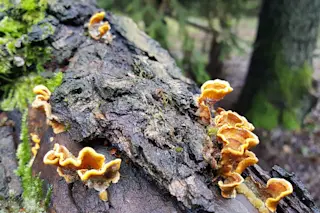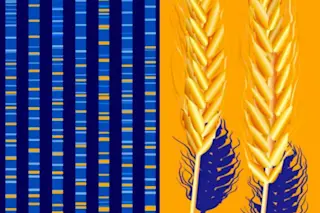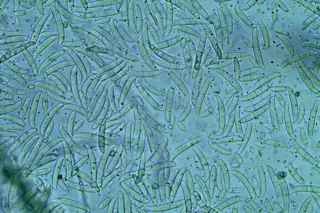When you bite into a juicy hamburger, slice into the perfect medium-rare steak, or gobble down a plateful of chicken nuggets, your senses are most likely responding to the food’s smell, taste, texture, and color. For a long time, these four attributes set meat apart from other food groups.
But in recent years, food companies have started to focus on the development of meat alternatives. Many people believe that transitioning away from meat-heavy diets can help with environmental sustainability as well as improve their own health.
The two main focuses of research have been on plant-based meat alternatives and lab-grown meat. Both have interesting challenges. Lab-grown meat requires growing animal cells and generating a meat product. Plant-based meat alternatives use plant materials to recreate animal-like structures and flavors.
Major food companies that have generated plant-based meat alternatives that consumers seem to enjoy include Impossible, Beyond Meat, Mosa Meat, and Quorn.
From a scientific perspective, the development of plant-based meat alternatives is especially intriguing because food manufacturers and researchers attempt to create products with similar textures, flavors, appearances, and nutrient compositions to those juicy hamburgers or tender chicken fingers.
As a biochemist who teaches students about how food fuels our bodies, I focus my research on the composition and the production of these products and how they can mimic animal meat is intriguing to me.
Animal meats are composed primarily of protein, fat, and water, with small amounts of carbohydrates, vitamins, and minerals. The animal tissue consumed is typically muscle, which has a distinctive shape made from fibers of protein that are bundled together with connective tissue.
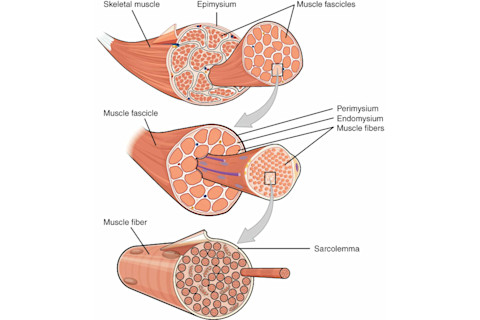
(Credit: OpenStax/Wikimedia Commons, CC BY-SA) Muscles, which animal meat comes from, contain muscle fibers banded together by connective tissue.
OpenStax/Wikimedia Commons, CC BY-SA
The size and shape of the protein fibers influence the texture of the meat. The amount and identity of natural lipids – fats and oils – found within a specific muscle tissue can influence the protein structure and, therefore, the flavor, tenderness, and juiciness of the meat. Meat products also have a high water content.
Typically, plant-based meat alternatives are made using nonanimal proteins, as well as chemical compounds that enhance the flavor, fats, coloring agents, and binding agents. These products also contain more than 50 percent water. To produce plant-based meat alternatives, the ingredients are combined to mimic animal muscle tissue and then supplemented with additives such as flavor enhancers.
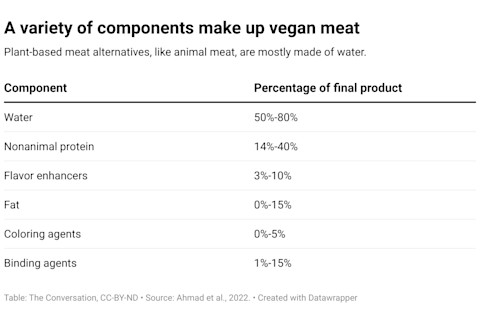
Developing a Meatlike Texture
Most meat replacements are derived from soy protein because it is relatively cheap and easily absorbs both water and fat, binding these substances so they don’t separate. Some companies will use other proteins, such as wheat gluten, legumes – lentils, chickpeas, peas, beans – and proteins from seed oils.
Since most animal meats include some amount of fat, which adds flavor and texture to the product, plant-based meat alternative manufacturers will often add fats such as canola oil, coconut oil, or sunflower oil to make the product softer and tastier.
Proteins and fats don’t easily mix with water – that’s why the ingredients in salad dressings will sometimes separate into layers. When using these components, food manufacturers need to emulsify or mix them together. Emulsification is essential to making sure the proteins, fats, and water form an integrated network with an appealing texture. Otherwise, the food product can end up greasy, spongy, or just plain disgusting.
Many vegan meat alternatives also use gelling agents that bind water and fat. They help with emulsification because they contain starch, which interacts strongly with water and fat. This allows for more of a mixed network of proteins, fats, and water, making them meatier and more appealing to consumers.

(Credit: FotografiaBasica/E+ via Getty Images) Fats, like oil, don’t readily mix with water. They need to be emulsified to become one homogeneous substance.
FotografiaBasica/E+ via Getty Images
Creating a product with a meatlike texture is not just a dump-and-stir process. Since animal meat is primarily muscle tissue, it has a unique spatial arrangement of proteins, fats, and water.
In order to mimic this structure, manufacturers use processes such as stretching, kneading, folding, layering, 3D printing, and extrusion. Right now, the most popular processing method is extrusion.
Extrusion is a method by which the dry ingredients – plant proteins and fats – are fed into a machine along with a steady stream of water. The inner part of the machine rotates like a screw, combining the molecules, converting the structure of the plant material from spherical shapes to fibers.
Each plant protein behaves differently in the manufacturing process, so some plant-based meat alternatives might use different ingredients, depending on their structures.
Adding the Savory Flavor
Although the texture is essential, meat also has a distinctive savory and umami flavor.
A set of chemical reactions called Maillard browning helps develop the complex, rich flavor profiles of animal meats while they cook. So, additives such as yeast extracts, miso, mushrooms, and spices can enhance the flavor of plant-based alternatives by allowing Maillard reactions to occur.
The aroma of cooked meats typically comes from chemical reactions between sugars and amino acids. Amino acids are the basic components of proteins. Lots of research has focused on attempting to replicate some of those reactions.
To promote these reactions, alternative meat developers will add browning agents, including specific amino acids such as cysteine, methionine, and lysine, sugars, and the vitamin thiamin. Adding natural smoke flavorings derived from hickory or mesquite can also give alternative meats a similar aroma.
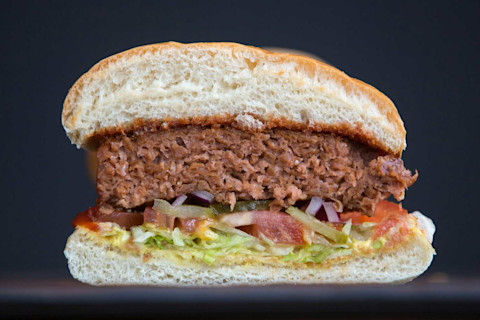
(Credit: Bloomberg Creative/Bloomberg Creative Photos via Getty Images) Plant-based burgers made with more lentil or pea protein tend to look more brown and meatlike.
Bloomberg Creative/Bloomberg Creative Photos via Getty Images
Eating With the Eyes
As the first-century Roman lover of food, Apicius said, “We eat with our eyes first.”
That means that even if the texture is perfect and the flavors are on point, the consumer will still decide whether they want to buy and eat the vegan meat by the way it looks.
For this reason, food manufacturers will usually develop plant-based meat alternatives that look like classic meat dishes – hamburgers, meatballs, sausages, or nuggets. They’ll also add natural coloring agents such as beetroot, annatto, caramel, and vegetable juices that make plant-based alternatives look more like the color of traditional meat.
Plant proteins such as soy and wheat gluten do not brown like animal meat. So, some food manufacturers will increase the proportion of pea and lentil proteins they’re using, which makes the meat alternative look more brown while cooking.
With some research, it’s not too difficult to mimic the structure, texture, flavor, and appearance of animal meats. But the question remains: Will people purchase and consume them?
It seems people do want plant-based meat. Countries all around the world have increased their demand for these products. In 2023, the global market was over US$7 billion, and it is predicted to grow by almost 20 percent by 2030.
Julie Pollock is an Associate Professor of Chemistry at the University of Richmond. This article is republished from The Conversation under a Creative Commons license. Read the original article.




